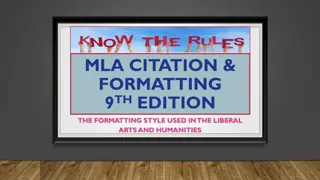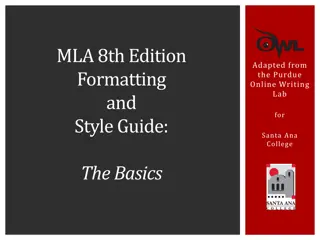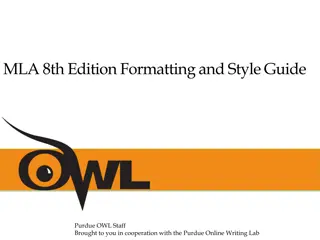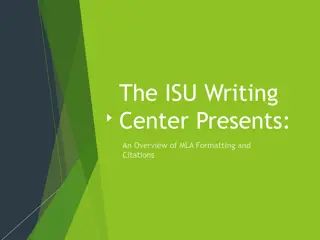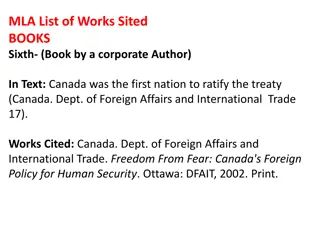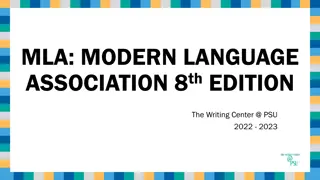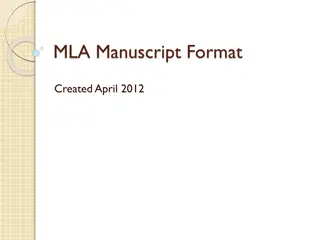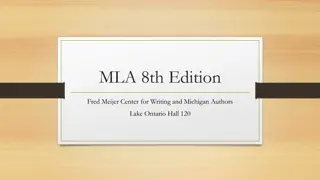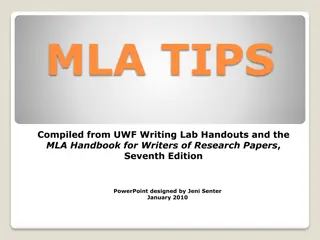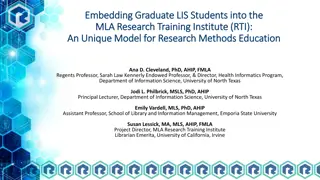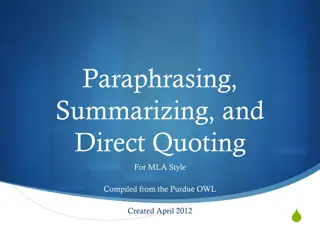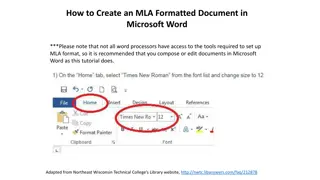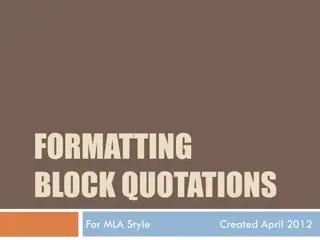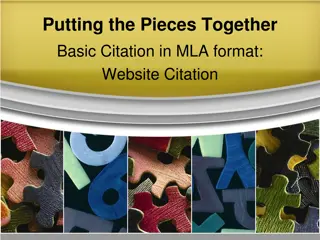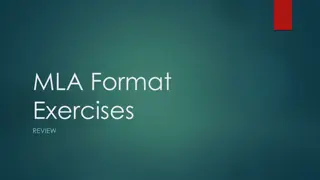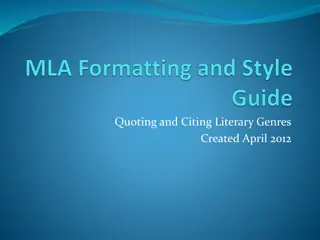
MLA Citation Updates and Changes for English Department
Explore the latest MLA citation guidelines including new formats, principles, and important changes for citing various sources. Learn about the emphasis on works cited page, principles over rules, and advancements in citing online sources with DOIs.
Download Presentation

Please find below an Image/Link to download the presentation.
The content on the website is provided AS IS for your information and personal use only. It may not be sold, licensed, or shared on other websites without obtaining consent from the author. If you encounter any issues during the download, it is possible that the publisher has removed the file from their server.
You are allowed to download the files provided on this website for personal or commercial use, subject to the condition that they are used lawfully. All files are the property of their respective owners.
The content on the website is provided AS IS for your information and personal use only. It may not be sold, licensed, or shared on other websites without obtaining consent from the author.
E N D
Presentation Transcript
MLA WHAT S NEW MAUREEN FITZPATRICK & KATHRYN BYRNE ENGLISH DEPARTMENT
PURPOSE REMAINS THE SAME Demonstrate thoroughness of research/argument Give credit where credit is due Share information
MLA Recognizes there is more than one correct way to cite a source . . . . A writer whose primary purpose is to give credit for borrowed material may need to provide less information than a writer who is examining the distinguishing features of particular editions of sources text. Similarly, scholars working in specialized fields may need to cite details about their sources that other scholars making more use of the same resource do not. (4)
NEW FORMAT Emphasis on the works cited page Focus on principles rather than rules (p3) Author. Title of Source. Title of Container, Other Contributors, Version (i.e. volume), Number, Publisher, Pub date, Location (of info). Punctuation requires only periods or commas:
PRINCIPLES Cite Simple Traits Common to Most Works Old version: used styles/information based on publication format New version: uses information or common elements (author, title, page#s) assembled in a logical order. MORE than ONE way to cite a source
WHAT IS NEW? Abbreviations Editor, edited by, translator, reviewed by are NOT abbreviated (96) Authors Three or more cite only first followed by et al. (22) Printed Works Pagination uses either p. or pp. then numbers (in text is numbers only) Publication city is no longer required Journals Volume and issue information: vol. 77, no. 2 (old: 77.2) Months and seasons always cited with the year.
WHATS NEW? (CONTD) Online sources Retrievable information is provided always: DOI preferred (replaces URL, 48) give example What s a DOI? (e.g: 10.1037/a0023101) A digital object identifier (DOI) is a unique alphanumeric string assigned by a registration agency (the International DOI Foundation) to identify content and provide a persistent link to its location on the Internet. The publisher assigns a DOI when your article is published and made available electronically. (Wikipedia) URL (NO http(s):// or angle brackets): www.pubmedcentral.nih.gov/articlerender.fcgi?artid/ 3145002&tool=pmcentrez&rendertype=abstract
WHATS NEW? (CONTD) Medium of publication is gone (no: Print, Web, microfiche, interview) Date accessed is optional Use no placeholders : n.d., N.p., n.pag. When an element is available in an external source use brackets. Otherwise omit.
WHATS NEW? (CONTD) Publishers Names are now in full but omit words like Company (or variations). Academic press abbreviations remain the same: U, P, and UP. Copublishers use a forward slash (e.g. MIT Press / Renaissance Quarterly ) Publisher as author, provide name only once, usually as publisher (omit author) Other possible omits for publisher s name: Periodical names (journal, magazine, newspaper) Website and publisher share same name Archives, content services, blog services (these are containers, not publishers) Reference materials now require full information as with other sources.
WHATS NEW? IN TEXT-- In text is unchanged but has added considerations: Time based references are cited in text, e.g. ( Shameless 00:16:03-10). indentation for block quotes (used to be a full 1 ) A, An, The as part of a periodical s title is now recognized in works cites list.
HELPFUL SITES https://youtu.be/bjbMfL92b7g
RESULT Writers are asked to think, select, and organize (p4) information in an uncomplicated way. More than one way to correctly document sources Writers generate useful documentation


